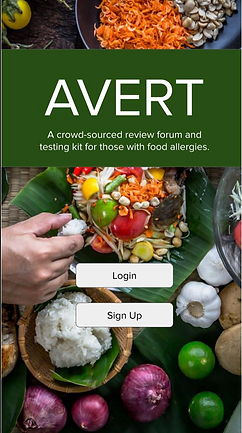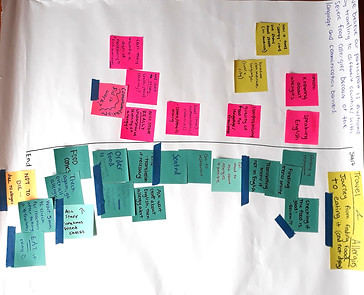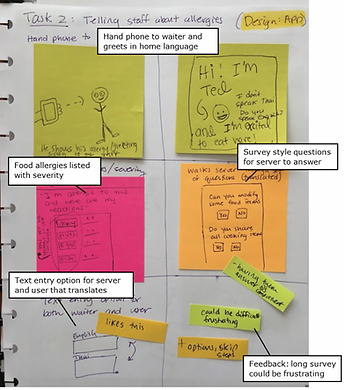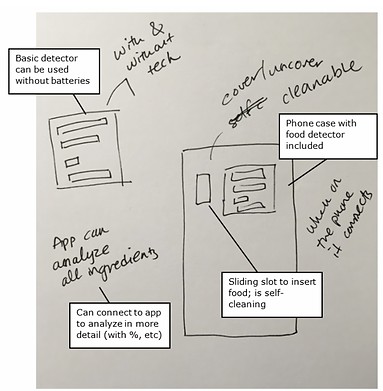Traveling with Food Allergies: A Participatory Design Project
Design and research project for accessibility & inclusive design course
Skills: teamwork, qualitative research, participatory design, prototyping, testing, presentation, report writing
How might we co-design an interactive product that promotes a more inclusive world for people with food allergies?
Objectives
-
Engage a participant co-design in order to promote inclusive design
-
Create and interactive prototype
Methods
-
Semi-structured interviews
-
Journey mapping
-
Storyboarding
-
Paper prototyping
Outcomes
-
Journey map
-
Design Requirements
-
Key Tasks for the solution to address
-
Medium fidelity prototype
Solution & Process

The Solution - AVERT
An app with community support for finding a safe place to eat, paired w/allergen tester



My Role - User Research
-
Selected methods & planned co-design sessions
-
Facilitated co-design session
-
Analyzed qualitative data & prioritized findings
-
Drafted problem statement for the team to align with
-
Identified design requirements & key tasks for solution to address
The Team
-
3 HCDE Master's students
-
A participant with severe food allergies
Research & Problem Definition Through Co-design
Semi Structured Interview
Findings:
-
Participant uses workarounds to accommodate allergies
-
Knowledge & cultural awareness is a barrier when traveling abroad with food allergies
-
Participant feels self-conscious (disliked bringing up allergies constantly) when eating at restaurants
Problem Scoping
After the interview, we decided as a group to focus on the issue of eating out at restaurants while traveling internationally, because:
-
It is an interesting problem
-
The solution might be useful in restaurants both abroad and at home.
Pink stickies =
concerns & barriers along the way

We used the results to align on a problem statement.
Journey Mapping Co-design Activity
We worked with our participant to map the journey of ordering food in an international setting and flagged potential pain points.
Journey purpose & goal
Blue stickies = steps taken on the journey to the goal
Problem Statement
We believe some people with food allergies are frustrated by international travel because the potential language and communication barriers might lead them to eat dangerous foods.
Ideation
After our participant left, the team used findings from the co-design session to create design requirements and key tasks for our solution to address.
Design Requirements
The solution must...
-
Translate between English and many other languages
-
Communicate allergies to restaurant staff
-
Convey the severity of allergies
-
Be discreet
-
Ensure the meal is safe to eat
Key Tasks
Task 1: Find a restaurant to eat at by viewing the menu ahead of time
Task 2: Communicate food allergies to non-English speaking staff and order a modified food item
Task 3: Confirm that the meal is safe
Brainstorming
We brainstormed many solution ideas including AR glasses, an interactive keychain, and an allergen tester. We selected our top two ideas: A robot with an allergen dectection feature and a phone app. These were chosen because they met the design requirements and assisted in the key tasks.

check-list of requirements



We storyboarded the Robot and App ideas by task type individually on sticky notes. Then we came together to combine our ideas.
Iteration Through Co-design

We presented our ideas to our participant and asked them to provide feedback by adding in sticky notes to the story boards.
Findings
-
Restaurant context is important: Our participant removed the step-by-step guided ordering feature. They felt the server may be too busy to engage with the app for a long period of time
-
Value in allergen detector: Our participant loved the allergen detector aspect of our robot idea. They suggested making something that could detect allergens both on and offline
Additional Design Requirements
The Solution...
-
Must allow for flexible communication between the user and the restaurant staff
-
Must work on a mobile phone, as our participant always has a phone while on the go
-
Essential aspects must be able to function off-line in case of limited wifi access
Updated Solution - AVERT an app for researching restaurants and communicating with staff, paired with an allergen detector that can be used without wifi.

Prototyping



We created a low-fi prototype in powerpoint, and 3-D printed the pop-socket allergen tester.
The app assists users with finding a restaurant, menu translation and ordering.
The pop-socket phone attachment acts as an allergen tester and informs the user if the meal is safe for them to eat (technology still in development).

Customize account to list food allergens by severity

View uploaded menus and crowd sourced reviews of restaurants to help find a restaurant that will accommodate specific allergies. The app's camera translate feature can be used to instantly translate menus to help determine if a restaurant is a good fit.

Test food with the pop socket phone attachment and view the results on the app.

Customize account to list food allergens by severity
Reflection
Future Directions
We showed our participant the final prototype and got this feedback to consider:
-
Allow the user to customize the severity rating language - not all allergies are the same
-
Restaurant Collaboration: Our participant mentioned that it would be helpful if “restaurants started uploading their menus.” We will consider creating account set up options for restaurant owners
Participatory Design Process
Advice for using this method:
-
Break down power dynamics: At first there was a noticeable power dynamic and the participant was a bit timid to suggest ideas. In the future I will dedicate more time to ice breaker activities to balance things more
-
Balance participant burden with method execution: We would have liked to create our first prototypes with our participant, but this would have required a lot of our participant's time
Overall, it was exciting to see how empowering inclusive design can be.
Our participant noted that the prototype “would provide such security … I could relax and eat. [Now] whenever I go out, I can’t relax.”